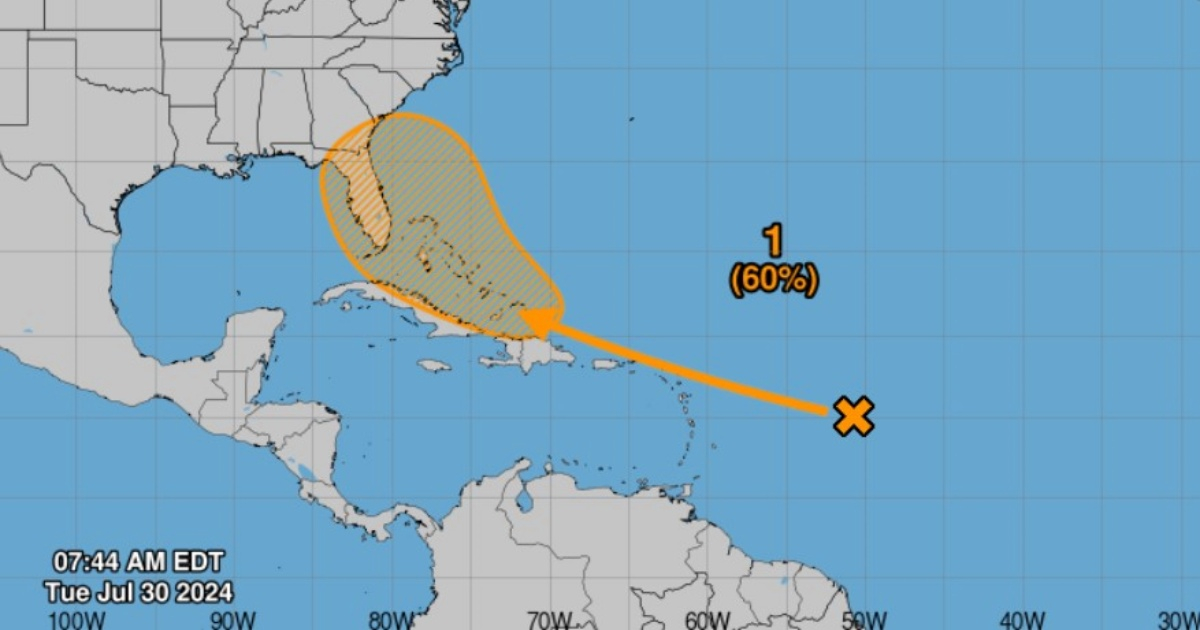The National Hurricane Center (NHC) has recently raised the probability to 60 percent that a tropical depression may form within the next seven days near the Greater Antilles and the Bahamas. "A large tropical wave located several hundred miles east of the Lesser Antilles is currently producing limited rainfall activity due to environmental dry air," the NHC stated.
However, the NHC warns that soon "conditions will become a bit more favorable for development over the warmer waters of the southwestern Atlantic Ocean," suggesting that a tropical depression could form by the end of this week. This system is expected to develop near the Greater Antilles or the Bahamas. Consequently, the U.S. climate entity advises that countries in the Greater Antilles, the Bahamas, and the southeast United States should closely monitor the system's progress. This warning is particularly crucial for Cuba and Florida, which should heighten their vigilance regarding the evolving weather phenomenon.
In the latest NHC forecast, the zone of potentially affected areas has shifted more to the north, indicating less influence on Cuba but significantly more on the Florida peninsula. Cuban meteorologist Raydel Ruisánchez confirmed in a social media post what the NHC had previously indicated. "The conditions at this moment are not favorable for development due to the presence of dry air. However, conditions are expected to become more favorable as it moves west near the Greater Antilles and the Bahamas, where there is a high ocean energy content with surface temperatures between 28-30°C," he noted.
The meteorologist added that it is recommended to maintain vigilance over this system as, regardless of its development, "an increase in rainfall is expected starting this Friday for the eastern and central regions of Cuba, extending to the west by the weekend."
Earlier this month, meteorologists from Colorado State University (CSU) in the United States increased their initial hurricane forecast for the current Atlantic cyclone season. They anticipated the formation of 25 named storms and 12 hurricanes, six of which could be of great intensity. A day after Beryl struck the state of Texas as a Category 1 hurricane early Monday morning, causing destruction and fatalities, the university's Department of Atmospheric Science added two named storms and one major hurricane to their forecasts made in early June.
This pioneering group in seasonal hurricane prediction updated their forecast based on the increase in averaged sea surface temperatures in the main tropical Atlantic and Caribbean hurricane development region, which remain near record warm levels. These temperatures "provide a much more favorable dynamic and thermodynamic environment for the formation and intensification of hurricanes," the university stated on its website.
Beryl set records by becoming the first hurricane, both in Category 4 and 5 of the Saffir-Simpson scale, to form so early in the 2024 cyclone season, which began on June 1 and ends on November 30. The University of Colorado is not the first organization to predict an above-average hurricane season. The National Oceanic and Atmospheric Administration (NOAA) of the U.S. forecasted in May a more active than usual season, with the formation of 17 to 25 named storms and up to 13 hurricanes, of which up to seven could be of great intensity.
FAQs on Tropical Depression Formation Near Greater Antilles and Bahamas
Given the increased likelihood of a tropical depression forming near the Greater Antilles and the Bahamas, here are some frequently asked questions and answers to help you stay informed.
What is the current probability of a tropical depression forming near the Greater Antilles and the Bahamas?
The National Hurricane Center (NHC) has raised the probability to 60 percent that a tropical depression may form within the next seven days near the Greater Antilles and the Bahamas.
Which areas should closely monitor the progress of this potential tropical depression?
Countries in the Greater Antilles, the Bahamas, and the southeast United States should closely monitor the system's progress. This includes specific attention from Cuba and Florida.
What are the anticipated effects if the tropical depression develops?
Regardless of its development, an increase in rainfall is expected starting this Friday for the eastern and central regions of Cuba, extending to the west by the weekend.
